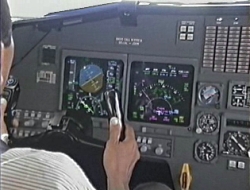ATC COMMUNICATIONS TRANSCRIPT
[Translation to English and Portuguese by AI, and ATC radiocommunication review by George Rocha]
AIRBUS 350-9 RADIO TUNED ON TOWER Frequency 118.725MHz
|
JAPANESE |
PORTUGUÊS |
|
|
In the accident
on the 2nd when an aircraft of Japan Airlines and the Japan Coast Guard
collided and burst into flames at Haneda Airport in Tokyo, the Ministry of
Land, Infrastructure, Transport and Tourism released the communication
records between the two aircraft and the control tower just before the
accident. Below is the full text of the published transcript. |
2日、東京・羽田空港で日本航空と海上保安庁の航空機が衝突し炎上した事故で、国土交通省は事故直前の両機と管制塔との交信記録を公開しました。以下、公開された記録全文です。 |
No acidente do dia 2, quando
uma aeronave da Japan Airlines e da Guarda Costeira do Japão colidiu e pegou
fogo no aeroporto de Haneda, em Tóquio, o Ministério da Terra,
Infraestrutura, Transporte e Turismo divulgou os registros de comunicação
entre as duas aeronaves e a torre de controle pouco antes do acidente.
Abaixo, a íntegra da transcrição publicada. |
|
ENGLISH |
JAPANESE |
PORTUGUESE |
|
Update on JA722A and JAL516` |
JA722AとJAL516に関する更新記録〈国交省配布・仮訳〉 |
Atualização em
JA722A e JAL516 |
|
|
|
|
|
|
|
|
|
1: JAL516 (Aircraft: 1st arriving aircraft)` |
1:JAL516(当該機:到着機1番目) |
1: JAL516 (1ª
aeronave chegando) |
|
2: JA722A (Japan Coast Guard aircraft)` |
2:JA722A(海上保安庁機) |
2: JA722A (aeronave
da Guarda Costeira do Japão) |
|
3: JAL166 (2nd arriving aircraft)` |
3:JAL166(到着機2番目) |
3: JAL166 (2ª
aeronave chegando) |
|
4: DAL276 (2nd departing aircraft)` |
4:DAL276(出発機2番目) |
4: DAL276 (2ª
aeronave de partida) |
|
5: JAL179 (3rd departing aircraft)` |
5:JAL179(出発機3番目) |
5: JAL179 (3ª
aeronave de partida) |
|
■17:43:02 JAL516)
Tokyo Tower, JAL516, Slot No. 18. Tokyo
Tower) JAL516, Tokyo Tower, Good evening`,
Continue your approach to Runway 34R. Wind 320 degrees, 7 knots. There is a departing aircraft` |
■17:43:02 JAL516) 東京タワー、JAL516 スポット18番です。 東京タワー) JAL516、東京タワーこんばんは。滑走路34Rに進入を継続してください。風320度7ノット。出発機があります。 |
■17:43:02
JAL516) Torre Tóquio, JAL516, Vaga 18. Torre Tóquio) JAL516, Torre Tóquio, Boa noite.
Continue aproximação para a pista 34R. Vento 320 graus 7 nós. Há uma aeronave
partindo
|
|
■17:43:12 JAL516)
JAL516 Continue to runway 34R.` |
■17:43:12 JAL516) JAL516 滑走路34Rに進入を継続します。 |
■17:43:12
JAL516) JAL516 Continuar para pista 34R. [Este
foi cotejamento] |
|
■17:43:26 DAL276)
Tokyo Tower, DAL276, taxiway C. Heading to the stop
position. Tokyo
Tower) DAL276, Tokyo Tower, Good evening. Drive
to runway stop position C1. DAL276)
Runway stop position C1, DAL276` |
■17:43:26 DAL276) 東京タワー DAL276誘導路上Cにいます。停止位置に向かっています。 東京タワー) DAL276、東京タワー こんばんは。滑走路停止位置 C1へ走行してください。 DAL276) 滑走路停止位置 C1
DAL276 |
■17:43:26
DAL276) Torre Tóquio, DAL276, taxiway C. Taxiando
para o Ponto de Espera. Torre Tóquio) DAL276, Torre Tóquio, Boa noite. Táxi
até a posição do Ponto de Espera
C1. DAL276) Posição
do Ponto de Espera C1, DAL276 |
|
■17:44:56 Tokyo Tower) JAL516
Runway 34R. No landing problems. Wind 310 degrees 8 knots` |
■17:44:56
東京タワー) JAL516 滑走路34R着陸支障なし。風310度8ノット |
■17:44:56 Torre de Tóquio) JAL516 Pista 34R. Sem
impedimentos para pouso. Vento 310 graus 8 nós |
|
■17:45:01 JAL516) Runway 34R. No landing problem, JAL516` |
■17:45:01 JAL516) 滑走路34R着陸支障なし JAL516 |
■
17:45:01 JAL516) Pista 34R. Sem
problema de pouso, JAL516 |
|
■ 17:45:11 JA722A) Tower,
JA722A, on the taxiway C.
Tokyo
Tower) JA722A, Tokyo Tower, Good evening. 1ª.
Proceed on the ground to the runway stop position on C5.` |
■17:45:11
JA722A) タワー、JA722A C誘導路上です。 東京タワー) JA722A、東京タワー こんばんは。1番目。C5上の滑走路停止位置まで地上走行してください。 |
■17:45:11
JA722A) Torre, JA722A, na taxiway C. Torre Tóquio) JA722A, Torre Tóquio, Boa noite. 1ª.
Prossiga na rádiofrequencia do Solo até a o Ponto de Espera
C5. |
|
■17:45:19 JA722A)
Head to runway stop position C5. 1st. Thank you.` |
■17:45:19 JA722A) 滑走路停止位置C5に向かいます。1番目。ありがとう。 |
■17:45:19
JA722A) Siga para o Ponto de Espera C5. 1ª. Obrigado. [Este foi cotejamento] |
|
■17:45:40 JAL179) Tokyo Tower, JAL179 Runway stop position C1.
Tokyo
Tower) JAL179, Tokyo Tower, 3ª. Drive to runway
stop position C1.
JAL179)
Run to runway stop position C1 and prepare for
takeoff` |
■17:45:40 JAL179) 東京タワー、JAL179 滑走路停止位置C1へ走行しています。 東京タワー) JAL179、東京タワー 3番目。滑走路停止位置C1へ走行してください。 JAL179) 滑走路停止位置C1へ走行、離陸準備完了
|
■17:45:40
JAL179) Torre Tóquio, JAL179, no Ponto de
Espera C1. Torre de Tóquio) JAL179, Torre de Tóquio, 3ª. Siga até o Ponto de Espera
C1. JAL179) Siga
para o Ponto de Espera C1 e prepare-se para decolagem |
|
■17:45:56 JAL166)
Tokyo Tower, JAL 166, Slot No. 21.
Tokyo
Tower) JAL166, Tokyo Tower, Good evening. 2ª. Continue
on the runway 34R approach. Wind 320 degrees 8 knots. There is a departure plane. Slow down to 160 knots.` |
■17:45:56 JAL166) 東京タワー、JAL166スポット21番です。 東京タワー) JAL166、東京タワー こんばんは。2番目、滑走路34R進入を継続してください。風320度8ノット。出発機あり。160ノットに減速してください。 |
■17:45:56
JAL166) Torre de Tóquio, JAL 166, Vaga
nº 21. Torre de Tóquio) JAL166, Torre de
Tóquio, Boa noite. 2ª. Continue para pista 34R. Vento
320 graus 8 nós. Há um avião em
partida. Desacelere até
160 nós.
|
|
■17:46:06 JAL166)
Deceleration 160 knots, runway 34R, approach
continued. Good evening.` |
■17:46:06
JAL166) 減速160ノット、滑走路34R 進入を継続。こんばんは。 |
■17:46:06
JAL166) Desaceleração 160 nós, pista 34R, aproximação
continuada. Boa noite. |
|
■17:47:23 Tokyo
Tower) JAL166, please, reduce to the lowest
approach speed.
JAL166)
JAL166’ |
■17:47:23
東京タワー) JAL166、最低進入速度に減速してください。 JAL166) JAL166 |
■17:47:23
Torre de Tóquio) JAL166,
por favor, reduza para a menor velocidade de aproximação. JAL166) JAL166
|
|
■17:47:27 (3
seconds silent)’ |
■17:47:27
(3秒無言) |
■17:47:27 (3
segundos silenciosos) |






























